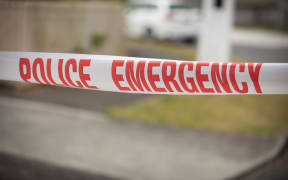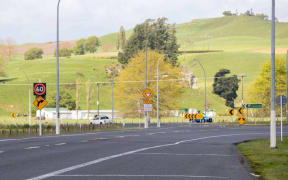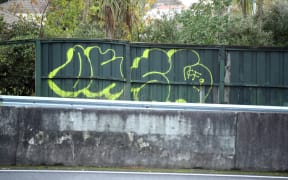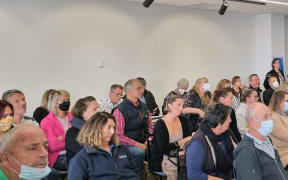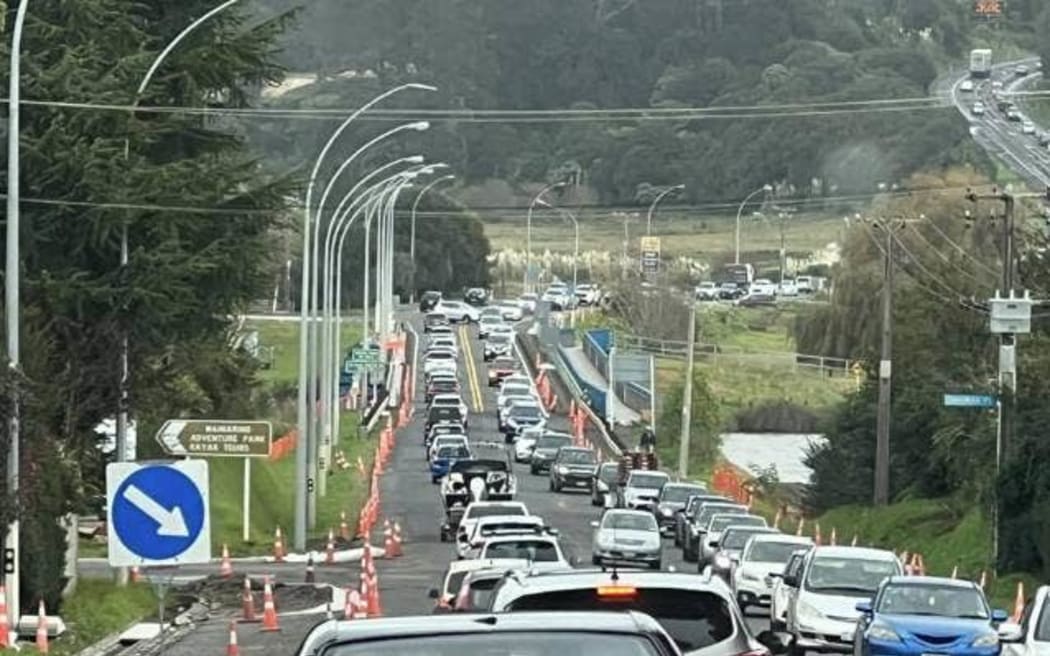
Traffic queues on State Highway Two to Tauranga. Photo: Stuff
Forget the weather and the economy, traffic is the talk of the town in Tauranga.
"Bloody hell, what is it with all the traffic in Tauranga?" asked one resident this month after it seemed like the whole city was brought to a standstill by a minor early morning crash in Mt Maunganui.
Commuters are frustrated by increasing traffic jams, seen as "worse than Auckland", with 77 percent of city dwellers citing congestion as a big problem, compared to just 40 percent in Auckland, 25 percent in Wellington, and 19 percent in Christchurch.
Roadworks on one state highway have forced people to move house, miss flights and hospital appointments, and even consider commuting to work on jetskis and golf carts.
Business owner Glenn Wilson missed his son's specialist hospital appointment that he had waited six months for because it took two hours to drive a 12km route that should take 10 minutes.
Another day, he missed a 6.30am flight, despite leaving his Ōmokoroa home at 4.45am. His worker Jony leaves his mum's house at 6.20am to travel just 7.5km to the office. It takes him more than an hour to get to work.
"It's worse than Auckland," he said, "Ludicrous.
"If you want to get somewhere on time you have to leave the night before. It's having a massive impact on people's businesses, lives and health. Everyone is fed up," Wilson said.
Tauranga teacher Ebony Kahukura is so over a two-hour drive to school on traffic-clogged State Highway 2 that she has put her house up to rent.
"This will be at a loss to me as the rent will not cover mortgage payments and rentals in town are dearer than here and the houses of poorer quality. To be honest it's s--t. I made huge sacrifice to get myself and my kids out here, bought an electric car to help balance out the travel cost and while it's a beautiful community, the traffic is just too much for my kids."
She has had to leave home with her two young children at 6am, getting them changed in the car and feeding them breakfast at school.
"By the time they start their school day, they're hungry and after school very tired ... very long days for five and seven year olds, plus afternoon traffic on the way home ... no end in sight with new roads planned for 2028 and that's years of roadworks."
Nick Turner considered hopping on his jetski after it took him one and a half hours to get to work in the Mount.
"It's impractical for me where I work. If I worked at the port, I'd give it some thought and would only take 10 minutes to shoot across."
A government worker, who Stuff agreed not to name, has been forced to work from home to avoid a two-hour commute.
"It's terrible. Some days I feel like crying."
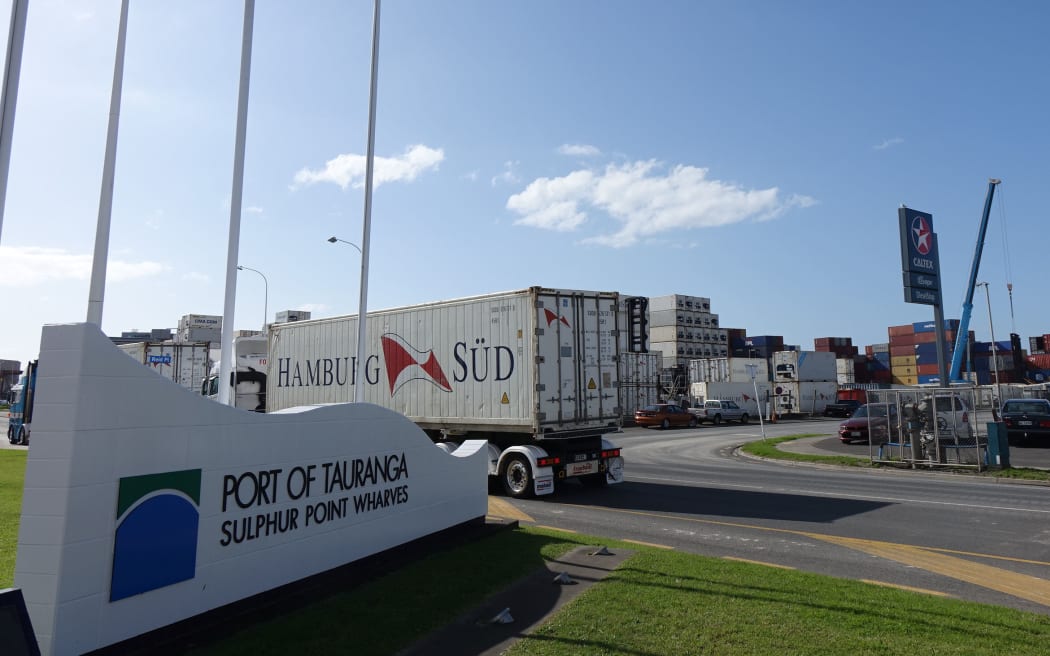
Freight heading to the port of Tauranga adds to congestion, but the solution is not more roads, Waka Kotahi says. Photo: RNZ / Joanne O'Brien
A recent survey comparing Tauranga to seven other cities in Aotearoa revealed 77 percent of residents considered traffic congestion "a big problem", and 97 percent think it is a problem.
Tauranga residents were the least frequent users of public transport in New Zealand in the survey, and viewed it least favourably.
By 2050, the western Bay of Plenty is projected to be home to 258,000 people, which creates one million transport movements per day, according to transport agency Waka Kotahi.
Waka Kotahi regional manager Jess Andrew said there were already "pinch points" in Tauranga, but more roads were not the answer.
"We need solutions to cater for growth in the western Bay of Plenty because we don't have the money or space to build more roads," Andrew said.
"The western Bay of Plenty is expanding faster than anywhere in Aotearoa New Zealand, and the topography of the region contributes to the pressure the growing population puts on roading infrastructure."
Highways such as SH2 from Ōmokoroa to Tauranga were once rural roads, but now carry freight and commuters, with an increase of more than 6000 vehicles per day added to this corridor in the past 10 years.
The main road in from the west, SH29 has seen a 64 percent increase in vehicles per day over the past 10 years.
Andrew said leaving the car at home was an option.
"By providing better infrastructure for walking, cycling and public transport, we can help encourage other ways of travelling that are safe and convenient."
One of the most car-dependent cities in NZ
Tauranga City Council transport director Brendan Bisley said Tauranga was one of the most car-dependent cities in New Zealand.
"For a lot of people - including tradespeople and businesses - using a private vehicle is a necessity, so we're targeting the 10 to 15 percent of the population who have a choice to walk, cycle, scooter, skateboard or catch a bus. If we can get those people on to a different mode of transport, the other 85-90 percent will have significantly less congestion and people can move around a lot better."
Congestion was likely to remain as the population continued to grow, Bisley said.
"There has been under-investment in our roading infrastructure over the past 15-20 years, and in that time the population has doubled ... now there are too many vehicles trying to drive across and around the city in the peak periods."
Tauranga's geography made it difficult to accommodate its traffic.
"Tauranga has limited arterial roads due to the city being built on narrow peninsulas, so building more capacity is difficult and expensive."
Investments, however, are on the cards with $1.4 billion to be invested in the Bay of Plenty in the 2021-24 National Land Transport Programme. Council has planned investment in roading infrastructure of $2 billion over the next 10 years.
Economic development organisation Priority One chief executive Nigel Tutt said infrastructure in Tauranga and the Western Bay had not kept up with growth.
"The population has grown 72 percent since the start of the century with only two major roading projects completed. Alongside congestion, it also has a significant effect on our ability to develop land - which leads to high house and rent prices. Our connection to the rest of Aotearoa for freight is critical too - we need to protect access to the Port of Tauranga, and to other cities in the Golden Triangle."
Longer term planning and alternative funding models were needed, Tutt said.
Tauranga Chamber of Commerce chief executive Matt Cowley said Tauranga had a poor record of executing roading projects, with too many agencies involved.
"NZTA's funding only looks three years out. It provides local councils and businesses with low certainty on which state highways will receive investment. Businesses look to establish themselves in a particular area, then the next government changes policies and cancels or delays major projects. The Tauranga Northern Link is a prime example."
Traffic issues were harming the city, Cowley said.
"Tauranga's traffic queues on our main state highways to enter the city are becoming well known for the wrong reasons. Businesses are concerned about the impact that traffic is having on employees. Buses are not a viable solution for our distributed workforce, particularly given that our economy has a lot of hands-on workers that cannot work from home.
"Businesses are also experiencing increasing costs from suppliers who are charging more for the time stuck in traffic. Customers are also making purchasing decisions based on who is easier to get to."
Empty cycle lanes were frustrating, he said.
"Tolling road users to fund bus and cycle lanes that have less than 5 percent of Tauranga's total trips has little support from businesses."
This was echoed at a recent meeting about Tauranga's traffic woes held by MP Sam Uffindell and National Party transport spokesperson Simeon Brown. The audience firmly said they did not want cycle lanes and did not want to cycle.
Tauranga's congestion was dramatically reducing people's quality of life, Uffindell said.
"It's a red cone nightmare."
* This story was originally published on Stuff.

